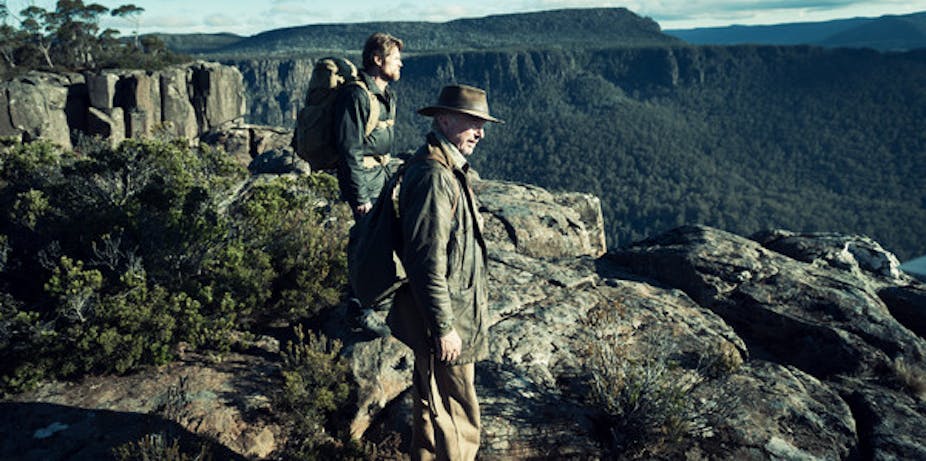All over the planet, a new wave of exploration and exploitation is taking place. Bioprospectors are searching for new and useful biological samples and compounds from previously unstudied animals and plants. It’s big business these days, especially for the pharmaceutical and biotech industries.
It’s also controversial: who has the rights to these compounds? The Convention on Biological Diversity was established in 1993 to prevent biopiracy. Many countries also now ban the export of biological material from native species because they fear losing revenue from as-yet-undiscovered biologically important compounds.
The ethical and environmental issues surrounding bioprospecting are at the heart of a new movie - The Hunter. The film follows bounty hunter Martin David (Willem Dafoe) as he searches the Tasmanian wilderness to collect DNA samples from a thylacine (Tasmanian tiger) on behalf of a mysterious biotechnology company, Redleaf.
Thylacines were relicts from a time before Aboriginal people and the dingos they brought with them. Along with Tasmanian devils and the marsupial lion, Thylacaleo, they were once found across much of the Australian mainland. Thylacines went extinct on the mainland perhaps 2000 years ago, and there hasn’t been a confirmed sighting in Tasmania for more than 70 years.
In the movie, Martin stalks the fabled tiger armed with a hunting rifle. His ability to fashion snare-traps from sticks would make Bear Grylls jealous.
Martin’s search for the last thylacine is much more dramatic than my own attempts over the last few years. Instead of a rifle, I’ve been using “ancient DNA” techniques to search for thylacine DNA in scats collected in the Tasmanian wilderness to find evidence that thylacines survived post-1936.
It’s fun, but is it science?
There is no reason why a real biotech company would pay big money for a sample of thylacine DNA. But when the reason for Redleaf’s motivation is given – thylacines had a unique toxin used to kill their prey – it is so far into the film that we can forgive this one glaring inaccuracy.
In fact, if you want thylacine DNA you don’t need a gun: in the modern genomics era anyone with a few hundred thousand dollars and access to a modern DNA sequencing machine could sequence the genome of a thylacine using a well-preserved sample from a museum specimen. But that would make spectacularly dull cinema.
Currently, a number of laboratories around the world are engaged in a race to sequence genomes of iconic extinct species. One or more thylacines are probably in their laboratory cross-hairs. But this race is motivated by the desire for scientific kudos and an understanding of past extinctions, rather than for biotechnological fame and fortune.
Thylacines were one of the first extinct species to be sequenced using “ancient DNA” techniques in the early 1990s. Scientific interest focused on the apparent close relationship between thylacines and marsupial carnivores of South America.
In more recent times small parts of the thylacine genome have also been sequenced. This work confirmed earlier findings and also hinted at low genetic diversity in the species.
Further genetic analysis of thylacines is unlikely to reveal much of interest to the biotechnology world. Genetic information could be obtained much more easily and cheaply by sequencing genomes of living marsupial carnivores such as quolls and Tasmanian devils.
Fictitious scenario, but the dilemmas are real
Science aside, the film showcases the fantastic Tasmanian wilderness and really brings to life the complex ethical, social and environmental issues at the very heart of sustainable use of biodiversity in places like Tasmania.
Here environmentalists and loggers fight real-life guerilla warfare to save wild places or their jobs. Martin arrives in Tasmania and lands in the middle of an ongoing clash between environmentalists and loggers where he paradoxically gets branded a “greenie”.
At the same time he finds himself playing father-figure to a family whose father disappeared while looking for a thylacine two years earlier. The film’s real strength comes from Martin’s journey as he struggles to conceal his mission from the greenies, loggers and family.
Ultimately the film focuses on his own ethical dilemma when faced with the reality of killing the last thylacine. There are plenty more subtle messages in this film for the scientifically astute or those who know some of the natural history of Tasmania. These all add to the scientific credibility of the story.
Overall, this film is much less about the science of genetic bioprospecting and much more about bioethical issues at the cliff edge of biodiversity loss in the modern world.

